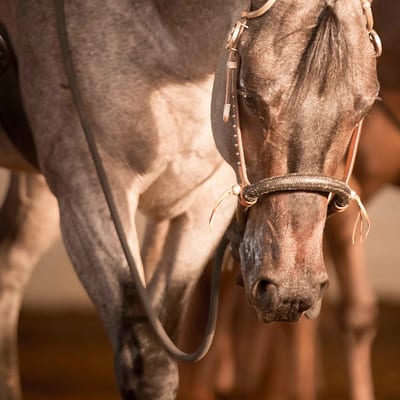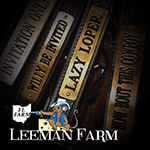In their own right, green horses are intriguing, difficult, powerful, talented, and gift us with many life lessons. A green horse is one that lacks experience or has not had much (or any) formal training. Perhaps the term ‘green horse’ is similar to the phrase ‘green as grass’ meaning inexperienced, new, fresh, or not tainted.
Another way to think about the phrase ‘green horse’ is in comparison to green wood. Green wood is freshly cut lumber that has not yet had water evaporated from it, leaving it supple, new, and able to be molded into what a craftsman envisions.
Our green horses work the same way. Their minds and physical abilities are fresh slates for a horseman to work with. Most equestrians would agree that there is nothing that beats the feeling of taking a green horse from nothing to something. Accomplishments like those are true success stories.
Each of the following eight lessons from a green horse leaves us with a new understanding of working with these incredible animals.
1) Developing an Eye for Detail
Whether you are shopping for a young show prospect or raise foals on your own, you have to know what you are looking at. Everything from confirmation to style matters when picking the horse that is right for you, and the discipline you want to compete in.
When it comes to young horses this task is at an elevated difficulty. There are sure signs of physical impairment, but it’s not always a tell-all sign that a horse won’t be competitive. Learning how to identify what traits might be detrimental to a horse’s career won’t ever be easy, but it’s a skill that you will learn as you compare horses.
Looking at horses in varying age classes can help as well. As a horse matures, some physical traits will change or become less severe. It’s always a good idea to talk to other people that have seen similar situations or are well-practiced before making a decision on a young horse.
2) Patience
Most horse show enthusiasts have either worked with a young horse or seen someone work with a young horse. Rule number one: nothing happens overnight, so don’t try and force it happen. Horses learn like you or me; with repetition. Repetition over a period of time is key to helping a young horse learn. It doesn’t make sense to ask a green broke horse to put its head down before it has learned how to properly move its legs.
The conformation of the horse and growth rate play a role in being patient. A young horse might still be developing and need more time to physically mature. This can potentially slow down the entire process, but does not indicate that a horse does not have what it takes.
The responsibility of working with a young horse helps you develop the patience and understanding it takes. Without patience, the process of becoming a team is nearly impossible whether you are a trainer or exhibitor.
3) Trust
Showing horses have given us a rare opportunity to partner with animals that could easily choose to hurt us. Why do they let us do this? The reason lies well beyond our enticing treats and two meals a day…trust.
Horses respond to riders giving them the confidence to do their job, but his confidence starts on the ground. Establishing a working relationship at eye level increases a horse’s willingness to perform when you are in the saddle.
Responding to pressure is a great example of an easy ground exercise and is necessary if you want to ensure a safe first ride. A horse has to know that pressure near its head or mouth does not mean something threatening. If this trust is not established on the ground you could be putting yourself in a dangerous situation.
This is only one example of a why trust is the biggest part of working with young horses. There are many others that lead to a safer and more enjoyable experience for both horse and rider.
4) Correctness
Even the most experienced riders have to go back to the basics when dealing with green broke horses. The process of teaching requires correct execution of each process and element. Repetition of correctness is just as important as the maneuver itself.
Green horses require this level of riding ability so they can start to associate what you are asking with their body movement. If a rider is asking for one maneuver in multiple ways (or an unclear way), the horse will not understand what it is that rider is asking. This causes a delay in progress, and often a causes problems in the long run.
On broke or finished horses, we tend to say they have ‘buttons.’ In many ways, this is true because they respond to cues that they have learned over time. After years of being asked the same way, these ‘buttons’ are very exact.
A rider taught the finished horse its buttons. A young horse needs the consistency and repetitive skill sets as a part of their training just like any other youngster (people and horses alike). Young horses hold you accountable for being a rider, not just a passenger.
5) Building Blocks
In the process of preparing your young horse for the show arena, it’s a good idea to set short term goals to gauge your progress. Each goal can be considered a building block toward success. Depending on your level of experience as a rider, success can be measured in different ways.
These building blocks and goals must be determined by each individual horse as well. All horses learn at a slightly different pace, like children, and adjusting your program to their learning needs is necessary.
Learning to set attainable goals is not just a practice that is important in the show arena. It’s a great habit to have to keep making progress.
6) Stay Humble
One of the hardest things to accept about showing a young horse is that they keep you humble. Green horses will make you work harder than you’ve ever had to work. You have to be perfect to help them, you have to be patient to teach them, and you have to be in control of yourself enough to have control of them.
If you have any experience with a green horse, you know it’s exhausting. Sometimes, even after all of the hard work you have put in, their young minds get the best of them when they enter the exciting unknown of the show arena. It happens to the best of them.
It’s in these moments that you become an even better rider. You brush it off, recover, and keep working to get the best out of your horse. Every stride matters to a young horse in the process of learning. Accepting the challenge of a young horse might not be easy, but it will remind you why sportsmanship and the true meaning of horsemanship go hand in hand.
7) Appreciation
If you want to appreciate a broke horse for everything they are worth, ride a green one. Often people do not realize how good they have it on their ‘been-there-done-that’ horse. Not that they don’t have their moments, but they take care of us by doing their job more often than not.
That’s not to say there are not things to appreciate about a green horse. A young horse’s raw talent is amazing. There is some fun learning each horse’s strengths and talents. When you find that special one, the work is almost addicting. As a rider, you have to appreciate the kind of work ethic a green horse can bring out in you.
8) Confidence
The are two main reasons that people who are learning to ride begin on finished horses; safety and confidence. Finished horses give inexperienced riders the tools to feel like they can do this on their own. When you step into the arena or a trail, it’s just you are your horse. Even if there are people around you, only you have control of what happens. Being able to communicate with your horse by giving them the correct cues is crucial.
When it comes time to move on to a less experienced horse, what we have learned over the course of our own riding careers shines through. It’s not always pretty and it is often a work in progress, but the more confident you can become in your riding ability, the more your horse will trust you.
* * * *
All of the things that are listed above come into play here. But once you get past the headache, time, and frustration that is the green horse, there is nothing that beats the feeling of success with your green horse. It’s important to recognize that success as a team effort. The horse had to decide to work and learn with you.
To anyone who has worked their way through this process, you understand. To anyone that is currently in this process, it’s worth it in the end. Be thankful for what they can teach you. Green horses offer us as much as we can offer them.








